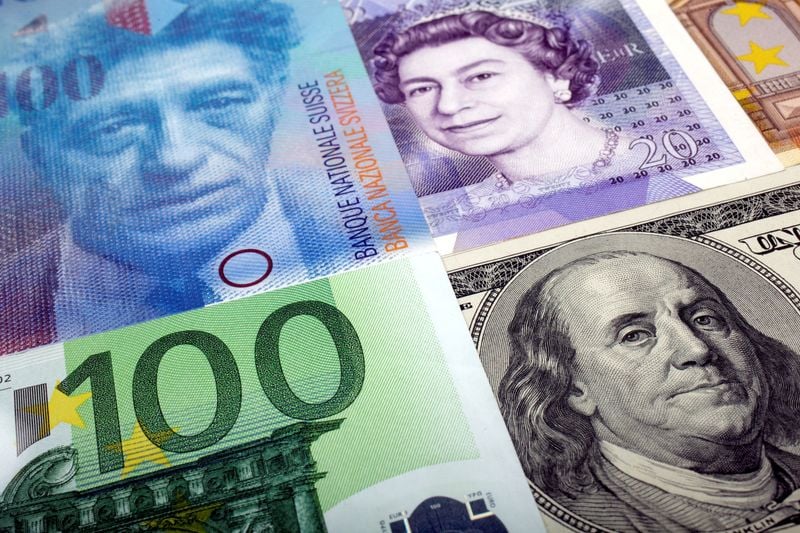By Yoruk Bahceli and Harry Robertson
(Reuters) – Banking turmoil on both sides of the Atlantic prompting the sharpest daily moves in decades in big government bond markets has made it much harder for investors to trade, but fears of a halt to market activity were so far muted, investors and traders said.
Bond markets have been whipsawed by last week’s collapse of Silicon Valley Bank and turmoil in European banks.
Two-year U.S. Treasury yields have slid 120 basis points (bps) over five trading days in their biggest cumulative drop since 1987 as bets on interest rate hikes were rapidly cut and financial stability worries lifted safe havens.
They jumped 20 basis points on Tuesday, but fell as much as 40 bps on Wednesday as bank fears broadened.
“Liquidity is poor pretty much across … most fixed income asset classes,” said Jon Jonsson, senior fixed income portfolio manager at Neuberger Bergman.
Jonsson said trades “that should take seconds took minutes” on Tuesday.
As prices swung wildly, the gap between buyer and seller prices on German bonds, the so-called bid-ask spread indicating the cost of transacting, widened to 0.036 point on Monday, MarketAxess data showed.
This was triple levels seen before SVB’s collapse and the widest in data going back to the start of 2021.
After stabilising somewhat on Tuesday, traders said Wednesday’s Credit Suisse-sparked turbulence that sent bond yields plunging again raised liquidity concerns.
“Definitely, compared to yesterday afternoon, liquidity has been drying up,” said Nils Kostense, head of government bond trading at ABN AMRO in Amsterdam.
“These fierce moves on the curve make it rather difficult getting liquidity. Small inquiries are no issue, these are still taken care of, but it’s bigger-size trades where there won’t be any liquidity.”
“Traders are definitely not keen to get risk on the books,” Kostense added.
German bonds bid-ask spread, https://fingfx.thomsonreuters.com/gfx/mkt/zjpqjnkyyvx/WiagT-cost-of-trading-german-bonds-surges-with-bank-rout.png
DEJA VU?
Some investors drew parallels with Russia’s invasion of Ukraine last year, when bond yields initially fell then jumped as surging energy prices fanned global rate expectations.
Zhiwei Ren, portfolio manager at Penn Mutual Asset Management, said the ability to trade in and out of positions “is definitely worse than the Ukraine war.”
“The bid-ask is three to four times wider than normal, that was my experience (on Monday),” he said.
Ren also compared trading conditions to the height of the 2020 COVID-19 pandemic, adding the biggest challenge at present is trading short-dated Treasuries, whereas back then the main challenge was trading longer-dated Treasuries.
In money markets, huge price moves on Monday were driven by low volumes and high volatility, two European traders said, with one of them adding that some dealers had not provided pricing.
NOT SO BAD
Commerzbank said on Tuesday trading liquidity was not evaporating as it did in previous stress episodes, with turnover on German short-dated bond futures reaching record levels.
Chris Jeffery, head of rates and inflation strategy at Legal and General Investment Management, said its traders have been “pleasantly surprised” by trading conditions relative to the news flow.
He noted that after the market turmoil caused by COVID-19 and the Ukraine war, all assets sold off at once, meaning investors had to either de-risk or raise cash by liquidating assets. This was not the case currently, he added.
BlueBay Asset Management senior fund manager Kaspar Hense said he was able to put on positions betting against interest rate risk without liquidity issues.
“Because there have been a lot of others, namely these hedge funds, which had been on the one side and needed to stop out, that’s why liquidity was good,” he said.
Investors said hedge funds that had held huge bets against bonds having to cover such positions had been big drivers behind the bond rally.
Ultimately, caution was warranted as liquidity could worsen if volatility continues.
“We don’t have these big buying forces in the background like we had in the past years,” ABN AMRO’s Kostense said, referring to central banks.
German, US two-year yield drops, https://fingfx.thomsonreuters.com/gfx/mkt/akveqezgbvr/2y%20yield%20drop.png
(Reporting by Yoruk Bahceli in Amsterdam and Harry Robertson in London; Additional reporting by Davide Barbuscia in New York; Editing by Dhara Ranasinghe and Matthew Lewis)
